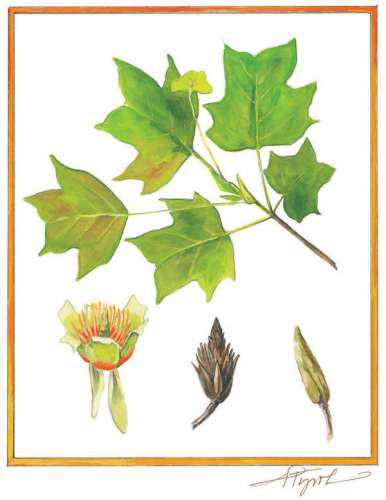
For the last 45 or so years, I have had to travel to be in the company of a tuliptree, as this species thrives only in more southern climes – from southern New England south to central Florida and west to Illinois. Nonetheless, this tree is dear to my heart. When I was a child in Connecticut, it was the most successful of the many transplants I made from the woods to our backyard. Tuliptree grows to impressive heights – 140 feet at age 100 on good sites in the Ohio River valley – and is known for having the longest branch-free bole of any American tree. Older forest-grown trees can have 80 to 100 feet of branchless trunk, with a 50-foot canopy of leaves above that. In the case of my tree, my parents were less enamored with these fast-growing traits than I was; when I went off to college, they cut the beanstalk-like creature down.
Undeterred, I later brought a succession of saplings and seedlings to Vermont, where I learned that deer relish the foliage, and that anything still alive above the snowline was likely to be killed by the sub-zero winter temperatures common here.
The tree has many unusual features, starting with large leaves that somewhat resemble the shape of an outline of a tulip. This four-lobed, rather rectangular leaf is not easy to describe but is unforgettable once you have seen one. Tuliptree is one of the few large trees to have truly showy flowers, and these, too, look like large tulips. The six greenish-yellow petals each have a bright orange splotch near the base. The beauty of the individual flowers often goes unnoticed as they tend to be borne on the far-away upper branches. But from afar, the higher reaches of a tree growing in the open will seem to glow with a yellow radiance when it is blooming. Many insects, including honeybees, gather nectar and pollen from the flowers, and quite a bit of tuliptree honey is produced in the southern states.
Over the summer, the unusual flowers develop into unusual fruits. Upright, conelike seed capsules stand upright and, after the leaves fall, the whole tree looks like an extravagant candelabra. During the winter, the outer scales and winged seeds fall away, but the central part of the cones remain erect on the bare twigs, making winter identification a cinch. The seeds are eaten by mice, squirrels, rabbits, and many birds. Even the winter buds are curious, for they are enclosed by two scales and look like a duck’s bill.
Tuliptree is sometimes called tulip poplar or yellow poplar, because its wood shares poplar’s quality of being light in both weight and color. It is, however, only very distantly related to poplars, being a member of the magnolia family.
It is also called whitewood, again for its light color, and canoewood because native Americans made huge canoes from tuliptrees. Later, Daniel Boone is said to have transported his family and all their gear down the Ohio River in a 60-foot-long canoewood canoe.
Impressive volumes of clear, straight-grained, high-quality wood are harvested from mixed hardwood stands that have a good percentage of tuliptree. Although crates, organ pipes, well linings, slack cooperage, and baskets are not in such great demand nowadays as they were in colonial times, the wood is still used for veneer cores, furniture, siding, molding, and a host of other products. It is easy to machine, takes paint well, and can be nailed without splitting.
Another reason that “poplar” has crept into its name may be because the leaves are on long, angled petioles, and like poplar leaves, they flutter restlessly in the slightest breeze. The glossy tuliptree leaf surfaces glitter in the sun, giving the whole tree a beautiful green brightness all summer. Their autumn color, a clear dazzling yellow, is very much like that of the true poplars.
Tuliptrees are the most commonly planted American tree in Europe and seem to be quite at home there. In either continent they live for well over 200 years and are truly magnificent in an appropriately spacious setting.

